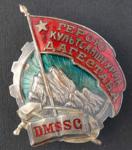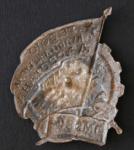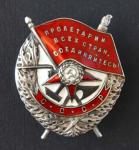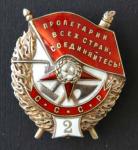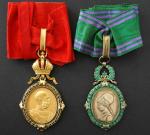-
Posts
1,161 -
Joined
-
Last visited
-
Days Won
17
Content Type
Profiles
Forums
Blogs
Gallery
Events
Store
Everything posted by Elmar Lang
-
The best would be to visit the Stuttgart Militaria show, and be present at the auction in person... I'll be there for sure! Enzo
-
Hello, I don't think that these Austrian decorations could be considered as a group (belonged to a single person, I mean). They count some pieces from the 1st Republic and the Hungarian Regency, plus a cross that's unknown to me (that silver/white enamelled cross with the eagle's head), possibly a private decoration. Best wishes, Enzo
-

Austria-Hungary An Austro-British medal
Elmar Lang replied to Elmar Lang's topic in Austro-Hungarian Empire
Hello, The medal is illustrated on Mericka's Book "Orden und Ehrenzeichen der Oesterrechisch-Ungarischen Monarchie", Vienna, 1974; on Proch?zka's "Oesterreichisches Ordenshandbuch", Munich, 1976, on Joseph v. Falkenstien (Dan Ragsdale): "Imperial Austrian Medals and Decorations", Tucson, Arizona, 1972, etc. (on "Oesterreichs Orden", Graz, 1997 there's illustrated a later striking in gold). Its measures are 60 mm. diam. and 280 grams; on the obverse the laureated head of the emperor facing right, with the inscription "IMP. CAES. FRANCISCVS. II. P. F. AVG."; on the reverse, the inscription "FORTI. BRITANNO. IN EXERCITV. FOED. AD. CAMERACVM. XXIV. APR. MDCCXCIV." ("To the courageous Briton in the Allied Army, near Cambrai, 24th April 1794"). The medal was suspended to the elaborate, typical gold chain made of round, flat S-shaped rings. In my opinion, it's the rarest Austrian military medal and the only one of its kind to expressely have an "international" meaning. I don't know if all medals survived (except the two I know that passed through the market), but it would be great to locate the other 6 pieces. Best wishes, Enzo -
Hello, Among the Austrian medals, there is one that is strictly connected to Great Britain: the Golden Medal for the battle of Villiers-en-Crouche, 1794, where 8 British cavalry officers were firstly rewarded from Emperor Francis II with an especially-made large gold medal to be worn at the neck by means of a golden chain; later, these officers were created knights of the Military Maria Theresia Order, still retaining the right to wear the medal as a visible sign of distinction and personal appreciation of the Emperor. To my knowledge, two of these medals appeared on the market, both sold by Spink's in the '60s; the first, offered for sale on the October 1966 issue of the Numismatic Circular and immediately sold; the second, sold to a famous collector in 1967. Are there any further awarded pieces known, in private hands or museums? Many thanks in advance, Enzo
-
I agree: Glenn's site is the best resource available on Austro-Hungarian military history. Elmar Lang
-
Hello, This time I would like to post the pictures -obverse and reverse- of a decoration or badge referred to Dagestan. The material is silver-plated brass or copper with gilt hammer & sickle and enamels. The reverse is engraved with the number "5". It measures 47 x 39 mm. Does anyone know more about this piece? Best wishes, Enzo
-

The Order of the White Eagle of Poland
Elmar Lang replied to Jani Tiainen's topic in Central & Eastern European States
Hi Jani, I've just seen your post on the Polish White Eagle Order. I have an identical piece, bought at Panasiuk's shop in Warsaw, in 1985. I think your piece too, was made by this firm. Kind regards, Enzo -
Yes... that velcro tape is a fascinating detail, something that gives this Alhaddin's cave treasure that fantastic "touch". Why didn't I buy an ex-Soviet oil company in 1990? If the prospective buyer would be interested, I have 2 meters of white velcro tape in my safe: I could sell it for ? 20.000,- (a real bargain!). Best wishes, Enzo
-

Soviet 1985 OPW I on eBay
Elmar Lang replied to Ferdinand's topic in USSR: Soviet Orders, Medals & Decorations
Well, it seems that the obverse is that of a decoration different from that depicted in those unsharp pictures of the reverse: this sounds quite strange. I think that the seller is going to get real troubles when the buyer would calmly tell him "nooow, how doo you thiiink to gow back hooome with bruoken ljegs?" (I'm trying to type with the typical russian accent from cold-war time spy-movies). In any case I'm not going to bid on that piece. Best wishes, Enzo -

Austria-Hungary A General with the "Literis et Artibus" Medal
Elmar Lang replied to Elmar Lang's topic in Austro-Hungarian Empire
...collecting is a neverending story... Now, I want HIS Commander's Cross of the RAO, not anyone's one! Enzo -

Soviet Орден "ПОБЕДА"
Elmar Lang replied to Elmar Lang's topic in USSR: Soviet Orders, Medals & Decorations
Hello, yes, of course, a copy is a copy, and a serious collector shouldn't have any, if possible. The good thing with the Victory Order is that any collector knows that if he would find one, it's a copy. Yes, I'm happy with this piece, bought for a rather ridiculous price, also compared to the prices of Soviet pieces, back in the '80s-'90s (the Viruti Militari bought on that same occasion was much, much more expensive...). To Marc: on an original piece, the white stones should be brilliants, on this copies there are white sapphires. At least, in my little collection, I have a copy made when the Soviet R?gime was still existing. Regarding the "genuine" one, does anyone know if King Michael's piece is still in private hands outside Russia o is it back to Moscow? Best wishes, Enzo -
Hello, since my pocket money wouldn't allow me to buy an awarded piece, here's a (wear? museum?) copy, purchased in 1988 in Warsaw: white gold, gold, sapphires and synthetic rubies. The stones are most accurately set and the overall appearance is impressive. The enamel on the "ПОБЕДА" scroll and the "CCCP" have been (quite badly) restored from me. The piece measures 70 x 72 mm. Best wishes, Enzo
-
Hi Rick, your piece is a fascinating one: wear, enamel loss and "updating" to suspension (plus being a documented piece), show all the "story" and "life" of that Red Banner. Yes, it seems that your order could be a further "variation" to Durov's series. After Kutsenko, my piece should have been awarded in the period June-October 1937. To Alex: I don't think I'll be going to sell my Soviet pieces. Thank you for your kind post, anyways. Best wishes, Elmar Lang
-

Austria-Hungary Regimental Tinnie of Austro-Hungaria?
Elmar Lang replied to Kev in Deva's topic in Austro-Hungarian Empire
Hello, this badge exists also in the "Kriegsmetall" zinc alloy. I've never seen it with a fastening pin, but always with two holes to sew it to the cap (although havier than most other "Kappenabzeichen"). Enzo -

Soviet Decoration of Marshal Rokossovsky
Elmar Lang replied to Alexandre's topic in USSR: Soviet Orders, Medals & Decorations
Hi, the cross on Marshal Rokossovski's breast is the 1st Class of the "Order of the Cross of Grunwald", instituted by the Polish authority under Soviet control in November 1943; decrees from February 20th 1944 and December 22nd of the same year. The proposal to institute this order came from the chief of General Staff of the People's Guard, Franciszek Jozwiak (May 1943); the order was designed by Stanislaw Nowicki, editor of the People's Guard's clandestine newspaper "Gwardiszta". The order, in its symbolic significance, had to remember the struggle of the Polish people against the Teutons, ended with the victory of Gr?nwald in 1410. The decree of institution of this order began with these words: "The Cross of Grunwald is a Polish decoration awarded for acts of gallantry in the armed struggle for the Liberty and Independence of Poland against the occupying forces...". The order was divided in three classes: 1st Class: a large gold (or -later- gilt) cross, the centre with a shield charged with two "antique" swords; on the reverse, a shield inscribed "1410 KG 1944"; 2nd Class: the same, but smaller; in silver, with gilt borders; 3rd Class: as the 2nd Class, but all in silver. From its institution and until 1983, this order was awarded 5738 times: 71 1st; 346 2nd and 5321 3rd Classes. The decorations were made in the Soviet Union, then at the Polish State Mint. Soviet-made pieces are very rare... As we can see, cross-shaped orders were still adopted or maintained from the Polish communist authorities (Virtuti Militari, Polonia Restituta, Cross of Grunwald, etc.), despite the other countries under Soviet influence. Best wishes, Enzo -

Soviet Order of the Red Banner 2d Award
Elmar Lang replied to Sal's topic in USSR: Soviet Orders, Medals & Decorations
Hello, to add some little data to this thread, my Red Banner orders "2" with ribbon, bear the numbers 5376 and 10676. The first of them is also struck with two small "1" marks on the reverse centre. Best wishes, Enzo -

Soviet Order of the Red Banner 2d Award
Elmar Lang replied to Sal's topic in USSR: Soviet Orders, Medals & Decorations
Hi Rick, all my Soviet pieces were bought in the late '80s and remained as a little "socialist wunderkammer" inside my collection. Now, I see that new, improved researches are going on and I hope to know more about the history behind some of my pieces. I see that also Soviet Orders & Decorations are "jumping" to fantastic prices, following what already happened to Tsarist pieces... that's a good reply to those collectors laughing at the few courageous looking for those strange and cheap-priced "signs of honour"... Yes, I think I'll let this piece be researched! Best wishes, Enzo -

Soviet Order of the Red Banner 2d Award
Elmar Lang replied to Sal's topic in USSR: Soviet Orders, Medals & Decorations
A very fine piece indeed! I would like to contribute with my Red Banner "2", of the screwback type, number 1348. It corresponds to Durov - Strekalov's Type 2, Variant 2, Subtype 1 (or 2?), illustrated on page 140. Best wishes, Enzo Below, the pictures of the obverse and reverse sides: -

Soviet Alexander Nevski
Elmar Lang replied to wlodzimierz's topic in USSR: Soviet Orders, Medals & Decorations
Hello, in the past, I've seen cast copies of the Nevskij Order, then silver-plated. They have a rather good appearance BUT, it's just necessary to touch the rim with a thumb's nail, that a sign remains, showing that the piece is made of soft metal (tin alloy). The same is for XX years RKKA medal and other orders, like Suvorov and Kutuzov. This type of copies appeared on the market (in Italy, through eastern Europe's dealers) in the early '90s. Best wishes, Enzo -

Austria-Hungary A General with the "Literis et Artibus" Medal
Elmar Lang replied to Elmar Lang's topic in Austro-Hungarian Empire
Hello, many thanks for the replies. The group appeared for sale in South Tyrol. The portrait photo has the mark of a frame-maker from Innsbruck and the seller told me that the group comes from that city, where it was for sale at an antique dealer. In the various passages, something was sold (f.e. the full-size Grand Cross of the Franz Joseph Orden) and other amenities. At last, a good friend of mine told me about the opportunity and I ran to the flea market where this dealer took the group. Before my arrival, other small pieces were away already; and in the pictures you can see what I've been able to take home. The French medal put for confrontation, is in my collection since the '90s and was for sale at Rauch, Vienna. The "Literis et Artibus" medal is very rare (well... please, not unique), so I'm quite happy for having added it to my Austrian "Wunderkammer". To Haynau: that "Feldbesteck" is a nice, gentleman's accessory! Best wishes, Enzo -

Austria-Hungary A General with the "Literis et Artibus" Medal
Elmar Lang replied to Elmar Lang's topic in Austro-Hungarian Empire
Hello Glenn, thank you for your reply: I think that you've solved the "mistery". General Wojnovich received the Ehrenzeichen f?r Kunst und Wissenschaft on April 4th, 1907; on an old Austrian book on the Franz Josef Orden, I've found his picture and it matches with the portait one, acquired with the medals. Your further observation is also right: it looks strange that with all these decorations a MVK is missing. Actually, when I've bought the group, it was partially "looted" already from other collectors. They bought other "lower" pieces, like another long service cross, buttons, other pictures and who knows what else. The seller was going to separate the whole (remaining) group, but after a short discussion I was able to take these pieces home. It's a pity when an interesting group is consciously split with the idea: "I'll get much more money". I'm happy with what I've found; I'm not happy with what -for pure ignorance- have been dispersed. Best wishes, Enzo -

Austria-Hungary Ignaz Joseph SCHMIDT Wien Jeweller
Elmar Lang replied to Veteran's topic in Austro-Hungarian Empire
Hi, in my preceeding post, I've forgtten to mention that a very similar piece is described and illustrated in "Oesterreichs Orden"; Graz, 1996, page 455 (n? 4.23) and plate 18, as made by Ignaz Joseph Schmidt. The Cross' size is: 32,2 x 27,7 mm. (suspension loop included, mobile suspension ring excluded). Today, I've had the opportunity to examine and measure my two Knight's Crosses of old type: 1) Cross: 34 x 31 mm. Crown: 33 x 28 mm. Ribbon width: 40 mm. This piece, although unmarked, corresponds in most details to a Schmidt-made cross. 2) Cross: 27,5 x 32 Crown: 26 x 27 Ribbon width: 38 mm. Both pieces are of the type after 1818; n? 1 has been "updated" (post 1820 award) putting a connecting link soldered to the lower crown's rim (the "doubled" ribbon loop is still present and the "old-fashioned" original triangular ribbon is still present); n? 2 is also an "updated" piece, but with a "barocque" crown and an elaborate "Kriegsdekoration" laurel wreath (a post-1859 addition). If interesting, I'll take some pictures of both pieces soon. Best wishes, Enzo -

Austria-Hungary A General with the "Literis et Artibus" Medal
Elmar Lang replied to Elmar Lang's topic in Austro-Hungarian Empire
-

Austria-Hungary A General with the "Literis et Artibus" Medal
Elmar Lang replied to Elmar Lang's topic in Austro-Hungarian Empire


